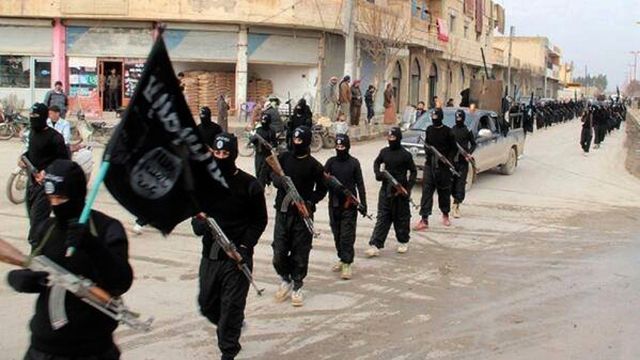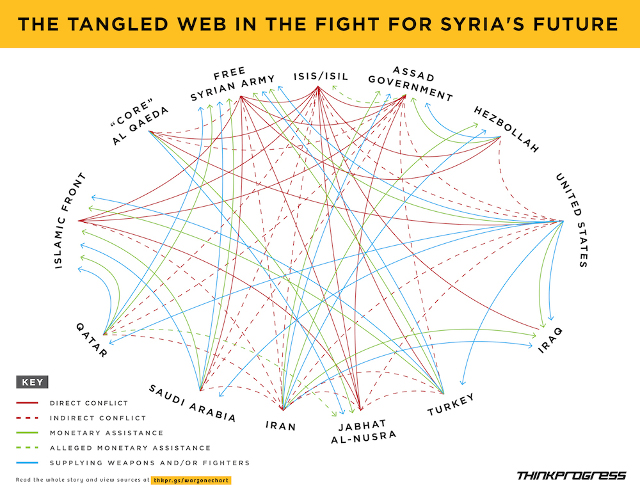
After American troops were withdrawn at the end of 2011, media coverage of the ongoing conflict in Iraq dwindled to almost nothing. But the country has been back in the headlines since a violent militant group called The Islamic State (IS) waged a fierce military campaign across Iraq.
At the same time, the Iraqi government in Baghdad is in the throes of a major political crisis, as Prime Minister Nouri al-Maliki faces a revolt from within his own party.
Confused about what’s going on? Wondering how the situation became so grim? We’ll try to answer some of the most pressing questions, with links to in-depth reports for those who want more information.
So What’s Happening in Iraq Right Now?
US forces have launched a series of airstrikes on Islamic State fighters in northern Iraq. On August 9, Barack Obama said that American warplanes were supporting Kurdish forces as they defend Erbil, an Iraqi city with a major US consulate and a number of American military trainers. The strikes also hit militants who have surrounded tens of thousands of Yazidis — members of a religious minority — who fled into the mountains and face starvation and dehydration.
Large swaths of Iraq and Syria have become one enormous field of battle — Agence France Presse reports that IS fighters bulldozed a berm separating the two countries in a symbolic act to advance their goal of a cross-border Islamic state.
IS gained control over much of Anbar province — including the city of Fallujah — back in January. In a backgrounder on that crisis for the Carnegie Endowment for International Peace, Raed El-Hamed writes that IS is pursuing a two-track strategy: occupying cities like Mosul, while launching hit-and-run attacks on others to keep the Iraqi army spread thin. VOX.com has a detailed map of towns that are or have been under IS control.
It’s been widely reported that when confronted with IS fighters, Iraqi soldiers, trained and equipped by the United States, have fled their posts and abandoned their equipment. But some troops have disputed those accounts. According to Asharq Al-Awsat, a leading Arabic newspaper published in London, Iraqi troops who had been stationed in Mosul say they received orders to abandon their positions from their superiors — they say they were told to don civilian clothing and “go home.”
The world has been stunned by photos released by the radical group purportedly showing the massacre of dozens of captured Iraqi soldiers, although the killings were not independently verified. Qassim Abdul-Zahra and Sameer N. Yacoub offered more details on that story for the Associated Press.
Meanwhile, the Kurds, who have participated in the government of Iraqi Prime Minister Nouri al-Maliki while maintaining an autonomous quasi-state in the North, “exploited the mayhem convulsing Iraq… to seize complete control of the strategic northern oil city of Kirkuk.” So report Tim Arango, Suadad al-Salhy and Rick Gladstone of The New York Times.Tensions between Iraqi and Kurdish officials run high, and it was only this week that the central government offered military assistance to the Kurds.
At McClatchy, Mitchell Prothero writes that Iraq’s senior Shiite cleric, Grand Ayatollah Ali al-Sistani, has broken his longstanding support for the central government and issued a religious call for Shiites to take up arms against IS militants.
Farnaz Fassihi reported for The Wall Street Journal that Iran, which has close ties to the Maliki government, deployed two units of its elite Quds Force — the Special Forces of the Iranian Revolutionary Guards — to battle IS militants in Iraq. At the end of June, The New York Times reported that Russia had sent 12 fighter planes to Iraq — and personnel to help operate them.
What’s this power struggle about?
In April, Maliki’s Iraqi National Alliance won a majority of the seats in parliament, and Maliki believes this gives him a mandate for another term. But members of his own bloc have turned against Maliki, who is viewed by many as an overly sectarian leader who has consolidated too much personal power. The bloc nominated Haider al-Ibadi, who has served as the Deputy Parliamentary Speaker, to be the next prime minister.
On August 11, Iraqi president Fouad Massoum gave al-Ibadi 30 days to form a government. But Maliki’s supporters are rallying around the current PM, and Maliki called the move a violation of the constitution. The New York Times reports that Iraqi troops and security forces loyal to Maliki have surged into Baghdad. Meanwhile, the BBC reports that Maliki is suing the president for his handling of the standoff.
The Obama administration and a number of senior American lawmakers have urged Maliki to stand down, arguing that his regime has alienated Iraqi Sunnis and made it more difficult to fight IS.
Who Are These IS Guys?
IS is a group of violent Islamic fundamentalists that first formed in Iraq in the aftermath of the US invasion as Jama’at al-Tawhid wal-Jihad, or “The Organization of Monotheism and Jihad.” It has gone by many names; today, it is also known as the Islamic State of Iraq and Syria (ISIS) and the Islamic State of Iraq and the Levant (ISIL). As the latter name implies, they ultimately aspire to create an ultra-conservative Islamic state in Iraq, Syria, Lebanon, Israel, Jordan, Cyprus and Southern Turkey.
To simplify a complex history, the organization, which was most familiar to Americans as “Al-Qaeda in Iraq,” began in late 2004 as a home-grown Iraqi Sunni insurgency group that pledged allegiance to Osama Bin Laden. It has expanded into Syria during that country’s civil war, where it attracted extremists from around the world and grew in numbers and strength. Last October, Liz Sly reported for The Washington Post that “thousands of Arabs and other non-Syrian Muslims” had “streamed into Syria over the past two years to join in the fight.”
Experts say that IS has now become so powerful and well-organized that it’s misleading to call it a “terrorist group.” Jessica Lewis of the Washington-based Institute for the Study of War told Time Magazinethat it now has “an advanced military leadership… They have incredible command and control and they have a sophisticated reporting mechanism from the field that can relay tactics and directives up and down the line,” she said. “They are well-financed, and they have big sources of manpower, not just the foreign fighters, but also prisoner escapees.”
Martin Chulov reports for The Guardian that IS has “secured massive cashflows from the oilfields of eastern Syria, and supplemented those revenues by robbing banks and looting antiquities.” According to Chulov, the network may have access to $2 billion.
Writing for The Atlantic, Aaron Zelin notes that IS has established a very severe form of Islamic law in areas it has occupied, while also employing “a soft-power governing strategy that includes social services, religious lectures, and da’wa (proselytizing) to local populations.” And at The Nation, Robert Dreyfuss suggests that there’s “a real danger that ISIS and its allies can set up a rump statelet in northwest Iraq and northern and eastern Syria controlled by ISIS, and its allies, including groups more closely affiliated to Al Qaeda.”
What’s the Regional Context Here?
This is both an Iraqi conflict, and also a tangled web of proxy wars fought along various regional fault lines.
This chart, by Hayes Brown and Adam Peck from ThinkProgress, is a helpful guide to all of the parties in this highly interconnected conflict:
Media accounts often focus on the discord between the Gulf states, led by Saudi Arabia, and the “Shiite crescent” — Iraq and Iran, where Shiites are the majority; Lebanon, where Hezbollah is a powerful faction; and Syria, where the Alawites (an offshoot of Shia Islam) are a dominant minority. As the chart above illustrates, this tension also affects Turkey, which has launched multiple strikes against Kurdish separatists in Iraq, and the Israeli-Palestinian conflict.
The Pew Research Center finds that throughout the region, from Tunisia to Egypt, there are “widespread fears” that the “violence in Syria would spill over into neighboring states.”
Are We Responsible for This Mess?
That’s an oversimplification.
It also takes a short view of history: As the birthplace of the three major Abrahamic religions — and the repository for a good chunk of the world’s oil reserves — the Middle East has long been plagued by conflict. The European colonial powers that sliced up the territory according to their own needs also deserve a lot of credit for its current instability — at GlobalPost, Charles Sennott writes that ISIS is in the process of “tearing up the map” created by France and Great Britain during World War I.
That said, it’s impossible to deny that the US invasion of Iraq in March 2003, plus a series of ideologically informed decisions by the Bush administration that followed, is the proximate cause of the bloody conflict raging there today.
The Bush administration went into Iraq with a “small footprint” — that is, insufficient forces to provide security — fired the army and police as part of its “de-baathification” program, privatized the Iraqi economy instead of investing in adequate public services and established a Shiite-dominated government that marginalized the Sunni community.
At The New Yorker, Dexter Filkins argues that the current wave of extremism in Iraq is “America’s legacy.” He writes: “When the Americans invaded they destroyed the Iraqi state—its military, its bureaucracy, its police force, and most everything else that might hold a country together.”
In 2004, The Atlantic’s James Fallows reported that “the Administration will be condemned for what it did with what was known. The problems the United States has encountered are precisely the ones its own expert agencies warned against.” Naomi Klein reported for Harper’s that the administration’s free-market ideology was the root cause of many of the problems that plagued US reconstruction efforts. In 2007, Nir Rosen wrote in The Washington Post that an “obsession with sects informed the U.S. approach to Iraq from day one of the occupation, but it was not how Iraqis saw themselves — at least, not until very recently. Iraqis were not primarily Sunnis or Shiites; they were Iraqis first, and their sectarian identities did not become politicized until the Americans occupied their country, treating Sunnis as the bad guys and Shiites as the good guys. ” That same year, Raed Jarrar and I said that US officials in Iraq had thwarted a number of plans for peace and reconciliation that had been put forth by parties that opposed the occupation.
The US also played a major role in Nouri al-Maliki’s rise to power following the handover from the Iraqi Coalition Government. Maliki has governed in a fiercely sectarian manner — Al-Monitor states that many “inhabitants of Mosul see the Iraqi army as a Shiite occupation army from Baghdad, and some civilians welcomed ISIS when they entered Mosul and removed all Iraqi army checkpoints. And while The Washington Post’s David Ignatius wrote back in 2007 that “the most important fact about Maliki’s election is that it’s a modest declaration of independence from Iran,” Maliki spent a decade in exile in Iran and, despite some ideological differences, the party he heads, Dawa, has received consistent support from Tehran.
Dexter Filkins reported for The New Yorker that a crucial deal that brought the current Iraqi government together was orchestrated by Qassem Suleimani, the head of Iran’s Quds Force and the architect of Syrian President Bashar al-Assad’s war against the Syrian insurgency.
What About the Domestic Politics?
It’s often the case that the more complex a situation is in the real world, the sillier our political discourse around it here at home is, and this conflict is no exception.
First, there has too often been a tacit assumption, more or less across the political spectrum, that the US has the power to “fix” Iraq if only it can get the policy right. But as Ramzy Mardini writes in The New York Times, “armed intervention by external actors into ongoing conflicts in the Middle East will likely add fuel to the fire.” He adds, “To effectively contain the militant threat spilling over from Syria will require the cooperation of various parts of the state and society in Iraq — from national, provincial and local to political, religious and tribal.”
But how can the U.S. fix a problem in which it has a fraction of a fraction of influencing the solution? For example, to stabilize Iraq will require stabilizing Syria; to stabilize Syria will require a regional settlement, among other things. The United States cannot force the Iraqis to come to terms with one another and cooperate. Washington is often perceived as supporting one political faction over another, especially through security-assistance to the regime.
Second, partisan charges that Barack Obama decided to withdraw all US troops from Iraq at the end of 2011 reflect a short memory. As Tony Karon observed for Time magazine in late 2011, “the decision to leave Iraq by that date was not actually taken by President Obama — it was taken by President George W. Bush, and by the Iraqi government.” In one of his final acts in office in 2008, Bush signed a Status of Forces agreement with the Iraqi government that guaranteed all US combat troops would depart the country by the end of 2011. Bush had tried to negotiate a longer stay, but the Iraqi government refused to grant US troops immunity from prosecution, a deal-breaker for the US military. At the time, a “senior Iraqi official” told Fareed Zakaria, “Maliki cannot allow American troops to stay on. Iran has made very clear to Maliki that its No. 1 demand is that there be no American troops remaining in Iraq. And Maliki owes them.”
Polls dating back to 2004 found that huge majorities of Iraqis saw US forces as “occupiers” rather than “liberators.”
The situation in Iraq — and Syria — is fluid. We’ll update as events unfold.



